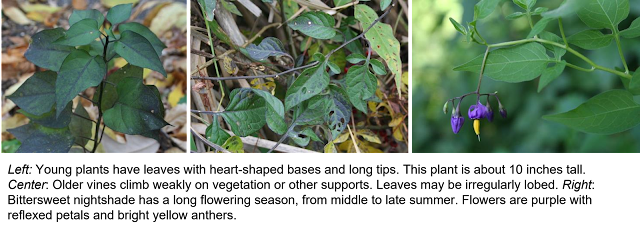|
Warning: Bittersweet nightshade is poisonous. Don’t eat it. Bittersweet nightshade, Solanum dulcamara, takes part of its common name from its taste. Its leaves and stems taste bitter and then sweet as its chemical components break down. The species name dulcamara comes from that quality. It's a combination of the Latin root words dulc, meaning sweet, and amar, meaning bitter. The origin of “nightshade” isn’t as clear. One explanation is that it comes from the narcotic effect of many plants in the genus Solanum. Bittersweet nightshade and its relatives contain solanine, an alkaloid that affects the nervous system. The solanine content of this plant is highest in its leaves and green fruits but eating any part can cause stomach upset, drowsiness, dizziness, delirium and in severe cases respiratory failure and death. Less ominously, “nightshade” could also come from the shady habitats where these plants may grow. Another origin could be the black berries that some Solanum species produce. Bittersweet nightshade isn’t one of them – its fruits are red at maturity – but other nightshades are well known for their black fruits. One of them is the highly toxic Atropa belladonna, commonly known as deadly nightshade or simply belladonna. The black berries of this plant are high in atropine, an alkaloid now used to dilate pupils for eye exams, treat low heart rates and counteract other poisons, among other medical uses. In earlier times, however, people used belladonna for other purposes, with some risk. During the Renaissance, Venetian women dropped diluted berry juice into their eyes to dilate their pupils, a look considered beautiful at the time. That effect is captured in the species name belladonna, meaning “beautiful woman.” There were darker uses for belladonna. Ancient Romans are said to have incapacitated or killed their enemies by contaminating their food supply with the plant, and stories abound of its use as an assassin’s poison. Accidental poisonings still occur from misuse of herbal products or ingestion of berries mistaken for blueberries or other edible fruits. Bittersweet nightshade isn’t as poisonous as belladonna, but it’s still best to be cautious. Its name speaks of its chemistry and the long, sometimes perilous history of the nightshade group. Before grabbing a handful of its berries, heed its name. It says beware. More about Bittersweet NightshadeAlso called woody nightshade or climbing nightshade, bittersweet nightshade is an
introduced vine now found throughout much of North America. It’s often associated with disturbed sites, especially those with wet or moist soils. Wetland edges, lakeshores, riverbanks, and deciduous forests are typical habitats. The vine grows up to twenty feet long, clambering over other plants or weakly twining around trees, shrubs or fences for support. In this region, bittersweet nightshade flowers from June to September. Fruits are oval, tomato-like berries about ½ inch long. They ripen from green to yellow, orange and eventually red. |
This introduced plant can be aggressive, especially in wet habitats that favor robust growth. It should be removed from places where children, pets or livestock may eat its leaves, stems or fruits. Bittersweet Nightshade is in the family Solanaceae, a group that also includes tomatoes, peppers, eggplant and potatoes. Tomatoes, peppers and eggplants are edible fruits; they contain little or no solanine. Potatoes tubers are also edible unless they’re exposed to sun and turn green from chlorophyll. Chlorophyll isn’t poisonous, but it shows that solanine may have accumulated in the tuber and could cause illness. References USDA Forest Service. The Powerful Solanaceae. Solanaceae (fs.fed.us). Website accessed October 30, 2021. Kandeler, R., and Ullrich, W.R. Symbolism of plants: examples from European-Mediterranean culture presented with biology and history of art: August: bittersweet, woody nightshade. https://www.cabi.org/isc/abstract/20093251708. Website accessed October 30, 2021. Flora of Wisconsin. Solanum dulcamara. https://wisflora.herbarium.wisc.edu/taxa/index.php?taxon=8664. Website accessed October 29, 2021. Waggy, Melissa A. 2009. Solanum dulcamara. In: Fire Effects Information System, [Online]. U.S. Department of Agriculture, Forest Service, Rocky Mountain Research Station, Fire Sciences Laboratory (Producer). Available: https://www.fs.fed.us/database/feis/plants/shrub/soldul/all.html [2021, October 27]. |





